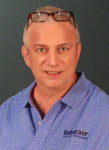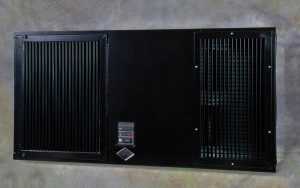— By Randolph Bush —
Thanks to commercial-grade air purifiers, smoke-free air entices customers to linger longer and order more from the menu.
For restaurants, too much accumulated indoor tobacco and food prep smoke and odor can become a serious problem that drives away customers and creates an unhealthy environment for employees. Even when smoking is designated to certain sections of a restaurant, the smoke can drift to common areas — creating an uncomfortable environment for all.

Randolph Bush, LakeAir
Patrons who are sensitive to smoke or concerned about their health will be quickest to avoid restaurants that do not adequately handle this issue. Employees may be forced to find alternative, healthier work environments. Even smokers will frequent an establishment less often and if they cannot enjoy its culinary tastes and aromas because they are sitting in a cloud of smoke that overpowers all subtlety.
Left unaddressed, smoke can even discolor a restaurant’s furnishings and a strong smoke odor can become difficult and costly to remove, creating a less than desirable environment.
One effective solution for restaurants is to install advanced air purification systems known as “smoke eaters” that filter large volumes of air quietly to remove both smoke and odors. In doing so, all customers can enjoy a more pleasurable experience that encourages lingering, ordering dessert and another cocktail or glass of wine. The approach also enables all diners to savor subtle nuances in the restaurant’s offerings, which encourages sampling appetizers and menu favorites.

In restaurants, cleaner air allows customers to enjoy their dining experience more fully. Every appetizer, entrée, dessert or beverage has its own complex mix of flavors and aromas. Wines and alcoholic beverages in particular are purchased at many different price points and can comprise a significant part of a restaurant’s sales profits, along with other add-on purchases. Clean, odor-free air allows the qualities of fine cuisine and beverages to be fully appreciated, so customers ultimately purchase more. These factors increase bill totals and profitability.
Extended exposure to smoke can also lead to physical discomfort, even for regular smokers. Over time, smoke can burn their eyes and get into their hair and clothes. This can cause even some smokers to spend less time in the establishment.
Opening doors and windows can help but is insufficient by itself. To improve the customer experience, a growing number of restauranteurs — particularly those that sell upscale products — are purifying the air and protecting their furnishings with advanced “smoke eater” air filtration.
 After researching their options for commercial-grade air filtration, a growing number are deciding to purchase smoke eater air purifiers. For greater aesthetic appeal, some of the most popular smoke eater air purifiers mount flush to the ceiling within the ceiling panel grid. Each unit is a dual blower electrostatic air purifier paired with an activated carbon filter that provides up to 1500 CFM of smoke and odor control with 97% efficient air filtration down to 0.1 micron.
After researching their options for commercial-grade air filtration, a growing number are deciding to purchase smoke eater air purifiers. For greater aesthetic appeal, some of the most popular smoke eater air purifiers mount flush to the ceiling within the ceiling panel grid. Each unit is a dual blower electrostatic air purifier paired with an activated carbon filter that provides up to 1500 CFM of smoke and odor control with 97% efficient air filtration down to 0.1 micron.
Electrostatic air purification is a 2-stage filtration system. In the first stage, the smoky air is drawn through the particle ionizer. Here, the smoke in the air is given a negative charge. The second stage is a series of collection plates. The charged smoke particles are attracted to the plates and are trapped. The smoke remains on the filter plates until they are removed when the filter is washed.
 The activated carbon filter traps any remaining smoke particles as well as odor molecules by adsorption inside the pore structure of the carbon substrate. After passing through the smoke eater filtration systems, purified air flows back out into the indoor area.
The activated carbon filter traps any remaining smoke particles as well as odor molecules by adsorption inside the pore structure of the carbon substrate. After passing through the smoke eater filtration systems, purified air flows back out into the indoor area.
After comparing all the specifications, many restaurant owners and managers select units with electrostatic air purification since they believe these would most effectively filter out the smoke and provide a better experience for their customers and employees.
Restauranteurs also appreciate a rather unique aspect of such units as well: their variable speed capability facilitates easy adjustment to the number of people dining, working and smoking inside.
Typical commercial units may have only a few operational speeds — which may not be selective enough to properly adjust to the changing occupancy of designated smoking areas. This can result in insufficient smoke filtration when it is most needed.
In contrast, the variable speed control of smoke eater units allows the user to deliver the exact amount of air purification for the occupancy of the designated area. Operating at the optimum speed for air purification also reduces the sound level. Customers often remark that on low and medium they do not hear the unit running. Even in turbo mode, the unit is considerably quieter than many commercial units.
Restauranteurs, employees and their customers can see and smell the difference that the units make when the smoke is cleared from the air in dining areas.
 Financially, such air purification systems contribute to the bottom line as customers seem inclined to spend more time in restaurants and make additional purchases.
Financially, such air purification systems contribute to the bottom line as customers seem inclined to spend more time in restaurants and make additional purchases.
Restaurant professionals also appreciate that such air filtration units are made in America with heavy-duty, all-steel construction for durability.
As the use of smoke eater air purification systems becomes more common in the restaurant industry, those still reluctant to consider them should think about a key principle of their business.
Restaurants need to keep their customers and employees comfortable when smoke accumulates indoors. Smoke eater units can unobtrusively accomplish this by clearing the air of smoke. This keeps the air clear and fresh, so dining is a more enjoyable experience that entices repeat business, referrals and long term employees.
— Randolph Bush is the owner and president of LakeAir, a Racine, Wisconsin-based manufacturer of commercial and residential air filtration systems since 1968. For more information, call 800-558-9436 or visit www.lakeair.com.
